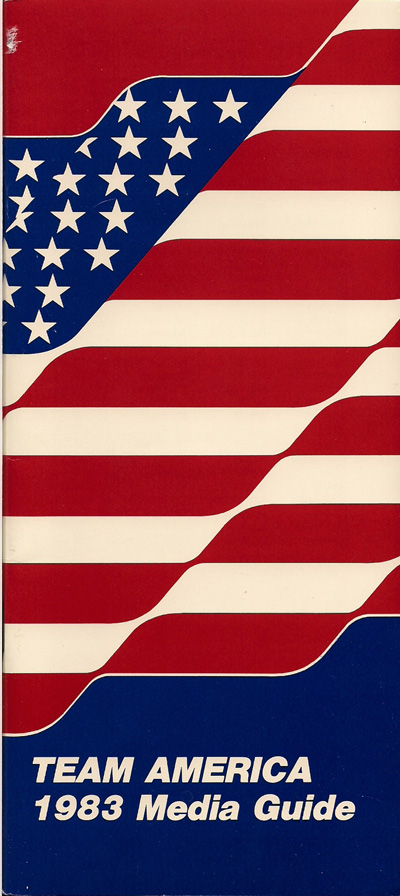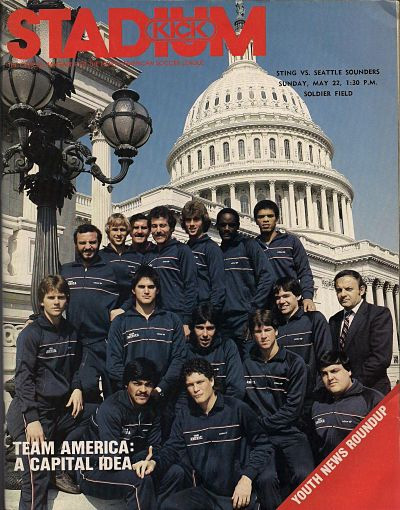North American Soccer League (1983)
Tombstone
Born: January 20, 1983 – NASL expansion franchise1Team unveiled to put America on Soccer map, From wire service reports via The Wilmington Morning Star, January 21, 1983
Folded: October 1983
First Game: April 23, 1983 (W 1-0 @ Seattle Sounders)
Last Game: September 3, 1983 (L 2-0 vs. Fort Lauderdale Strikers)
Soccer Bowl Championships: None
Stadium
RFK Stadium (55,000)21983 Official North American Soccer League Guide
Branding
Team Colors: Red, White & Blue31983 Official North American Soccer League Guide
Ownership
Owners: Robert Lifton, Howard Weingrow, Warner Hodgdon & Mike Curb
Attendance
A post-game Beach Boys concert for a June date against the Fort Lauderdale Strikers helped draw 50,000 to RFK, more than a quarter of Team America’s annual total.
Tap (mobile) or mouse over chart for figures. Tilting your mobile device may offer better viewing.
Source: Kenn.com Attendance Project
OUR FAVORITE STUFF
North American Soccer League
The NASL Collection is coming soon to Royal Retros
Background
Team America was a novel idea that flopped on arrival for the faltering North American Soccer League in the spring and summer of 1983. From an all-time high of 24 clubs in 1980, the NASL shrunk to just 12 members by 1983.
New league CEO Howard Samuels, who took over management of the league in June 1982, believed that the NASL needed to shift away from its dependence on pricey, aging foreign imports and work to develop more relatable American players to promote interest in the league. At the same time, the United States Soccer Federation wanted to get serious about developing a competitive U.S. National Team to compete in the 1984 Los Angeles Olympics and that might qualify for the World Cup in 1986, something that the U.S. hadn’t accomplished in 36 years.
Samuels and the USSF decided to form Team America, made up of 20 of the best American players in pro soccer, and enter it into the NASL as an expansion team (sort of) for the 1983 season. Team America would be based in Washington DC and play at RFK Stadium. A patriotic address to be sure, but also a city and venue where two separate NASL franchises known as the Washington Diplomats had folded within the past 30 months.
In addition to competing in the pro league, Team America would also be the U.S. National Soccer Team in training, preparing for the following summer’s Olympics and tuning up for the World Cup qualification process. The USSF had the right to appoint Team America’s Head Coach and selected former Greek National Team manager Alkis Panagoulias.

Cigarette Money
Team America also needed a private investor group to back the team, so Samuels recruited New York businessman Robert K. Lifton, who in turn brought in his long-time associate Howard Weingrow and a couple of NASCAR impresarios, Mike Curb and Warner Hodgdon. Lifton’s group managed to secure a $1 million corporate sponsorship from the R.J. Reynolds Tobacco Co. to promote its Winston Cigarettes brand through the club. Team America’s 1983 NASL schedule, along with handful of dates against international competition, was promoted as the “Winston Team America Series”. A tobacco sponsorship for the U.S. National Soccer Team would be unthinkable in contemporary America. Back in the early 1980’s it was one of the largest team-level corporate sponsorships in the history of American pro soccer.
The Winston deal was also one of the only things that went well for Lifton’s group and for the Team America concept. One major problem was the composition of the team. The best American players, of course, were already under contract with other NASL clubs or with the rival Major Indoor Soccer League. A mechanism was set up to allow rival NASL clubs to loan their players to Team America. But no one seemed to anticipate that some players wouldn’t want to go.
American No-Shows
Top Americans such as Rick Davis, Angelo DiBernardo and Steve Moyers of the New York Cosmos and Mark Peterson of the Seattle Sounders declined to leave their clubs to play for Team America. Peterson was significant, as the NASL’s reigning North American Player of the Year for the 1982 season. (With the Sounders themselves in organizational disarray, Peterson would later reconsider and join Team America for the season’s final month). Rick Davis’ refusal to go along gained the most press attention. The 24-year old midfielder was arguably the highest profile American-born player of the early 80’s. Part of Davis’ stature was related to playing for and touring the world with the star-studded Cosmos club. He was understandably reluctant to leave.
On The Field
Among the players who did show up, Team America landed promising young defenders Jeff Durgan from the Cosmos and Dan Canter from the Fort Lauderdale Strikers. Defense was the strength of the team. Goalkeeper Arnie Mausser was one of the most experienced American-born players. But many of the Team America players were recently naturalized citizens. South African-born Andrew Parkinson was Team America’s leading scorer with 12 goals.
After a strong start at 8-5, Team America’s lack of offensive ability doomed the team. A 2-15 slide to finish the 1983 season gave the club the second worst record in the NASL at 10-20.
Demise & Epilogue
Owner Robert Lifton folded the club immediately after the NASL season ended in September 1983. Oddly, the failure of the Team America experiment also helped to drag down another NASL franchise in 1983. The Montreal Manic, owned by Molson Breweries, announced plans to shift to a “Team Canada” concept for the 1984 season, with plans to shed their best foreign players in favor of all-Canadian team to prepare for the 1986 World Cup. Although the Manic continued to play with an international cast in 1983, the planned transition was so unpopular with the team’s French Canadian fan base that attendance collapsed. Molson folded the club in frustration in November 1983.
Alkis Panagoulias coached the U.S. National Team in the 1984 Olympic Games, but the U.S. failed to qualify for the 1986 World Cup, which was one of the stated aims of forming Team America. The Americans would finally qualify in 1990, ending a forty-year exile from the planet’s most popular sporting event.
Voices
“The team never got the top scoring players from the NASL, either because the players did not want to leave their teams, or the NASL owners were not prepared to give up the American players who could score, since they wanted those players to attract local fans. So the team ended up with a strong defense and no offense of consequence… when you have a team that can’t score but can only hold down the scoring of the other side, you end up with games with very little scoring action. When I had representatives of Winston <Cigarettes> in the owner’s box at RFK Stadium, after a while neither they nor I had an interest in following the game.”
-Robert K. Lifton, Owner 1983 (2012 memoir An Entrepreneur’s Journey: Stories From a Life in Business and Personal Diplomacy)
Team America Soccer Shop
Editor's Pick
Rock n' Roll Soccer
The Short Life and Fast Times of the North American Soccer League
by Ian Plenderleith
The North American Soccer League – at its peak in the late 1970s – presented soccer as performance, played by men with a bent for flair, hair and glamour. More than just Pelé and the New York Cosmos, it lured the biggest names of the world game like Johan Cruyff, Franz Beckenbauer, Eusebio, Gerd Müller and George Best to play the sport as it was meant to be played-without inhibition, to please the fans.
The first complete look at the ambitious, star-studded NASL, Rock ‘n’ Roll Soccer reveals how this precursor to modern soccer laid the foundations for the sport’s tremendous popularity in America today.
When you make a purchase through an affiliate link like this one, Fun While It Lasted earns a commission at no additional cost to you. Thanks for your support!
Team America Video
Team America host the Tulsa Roughnecks at RFK. August 21, 1983.
In Memoriam
Forward Mark Peterson passed away on July 7, 2011 at age 51.
Former Team America manager Alkis Panagoulias died on June 18, 2012 at age 78. Washington Post obituary.
Team America minority owner Warner Hodgdon died on March 20, 2013 at age 80.
Midfielder Pedro DeBrito died July 5th, 2014 from injuries in a car accident two days earlier. He was 55.
Downloads
1983 Team America Group Ticket Sales Advertisement
1983 Team American Group Ticket Sales Flyer
March 1983 – RJ Reynolds Press Release Announcing Winston Cigarettes Sponsorship of Team America
6-17-1983 Team America vs. New York Cosmos Game Notes
7-6-1983 Team America @ New York Cosmos Game Notes
8-8-1983 Mark Peterson Joins Team America Press Release
8-10-1983 Team America vs. Cosmos Game Notes
Links
Ian Plenderleith USSoccerPlayers.com interview with Team America veteran Alan Merrick
###




2 Responses
Thanks for the shout-out Kenn!